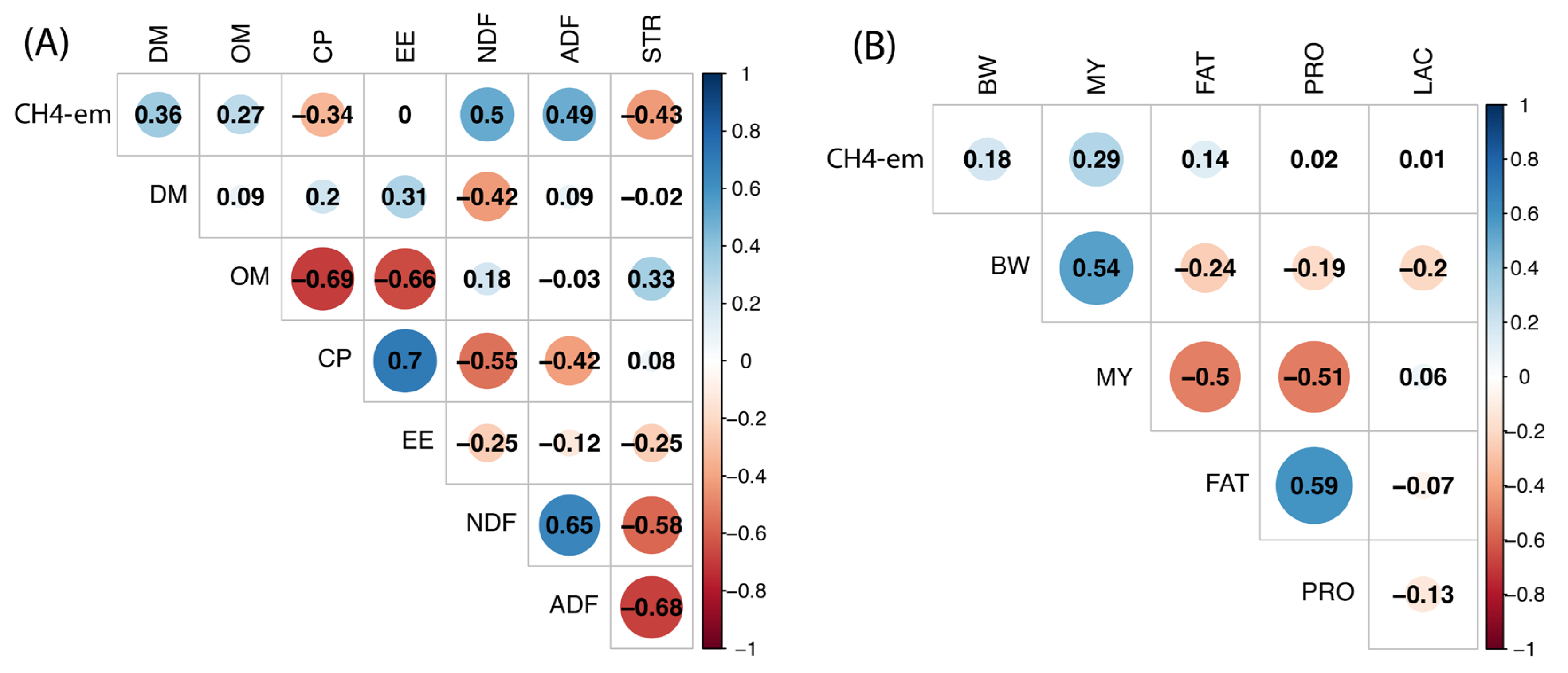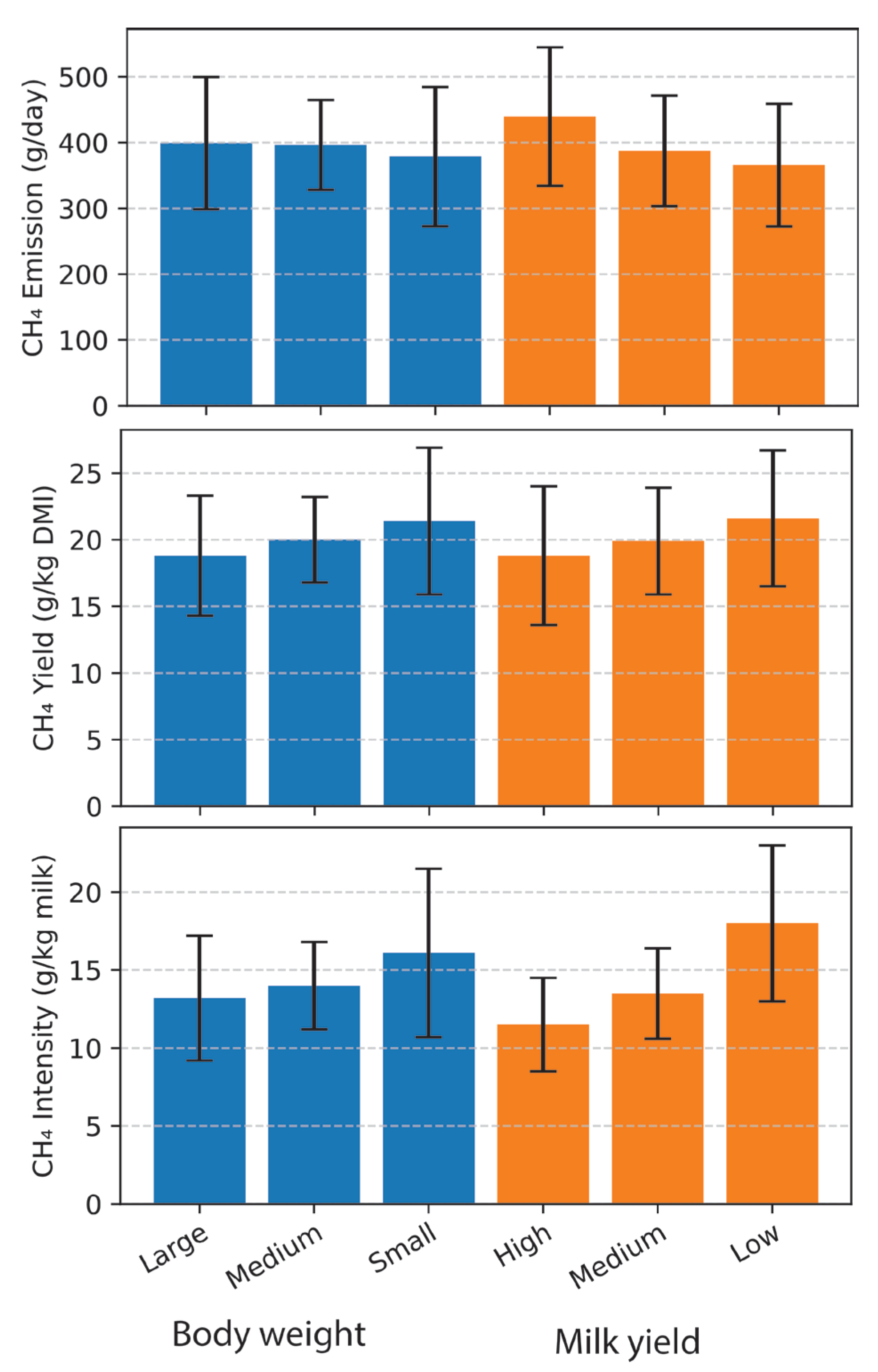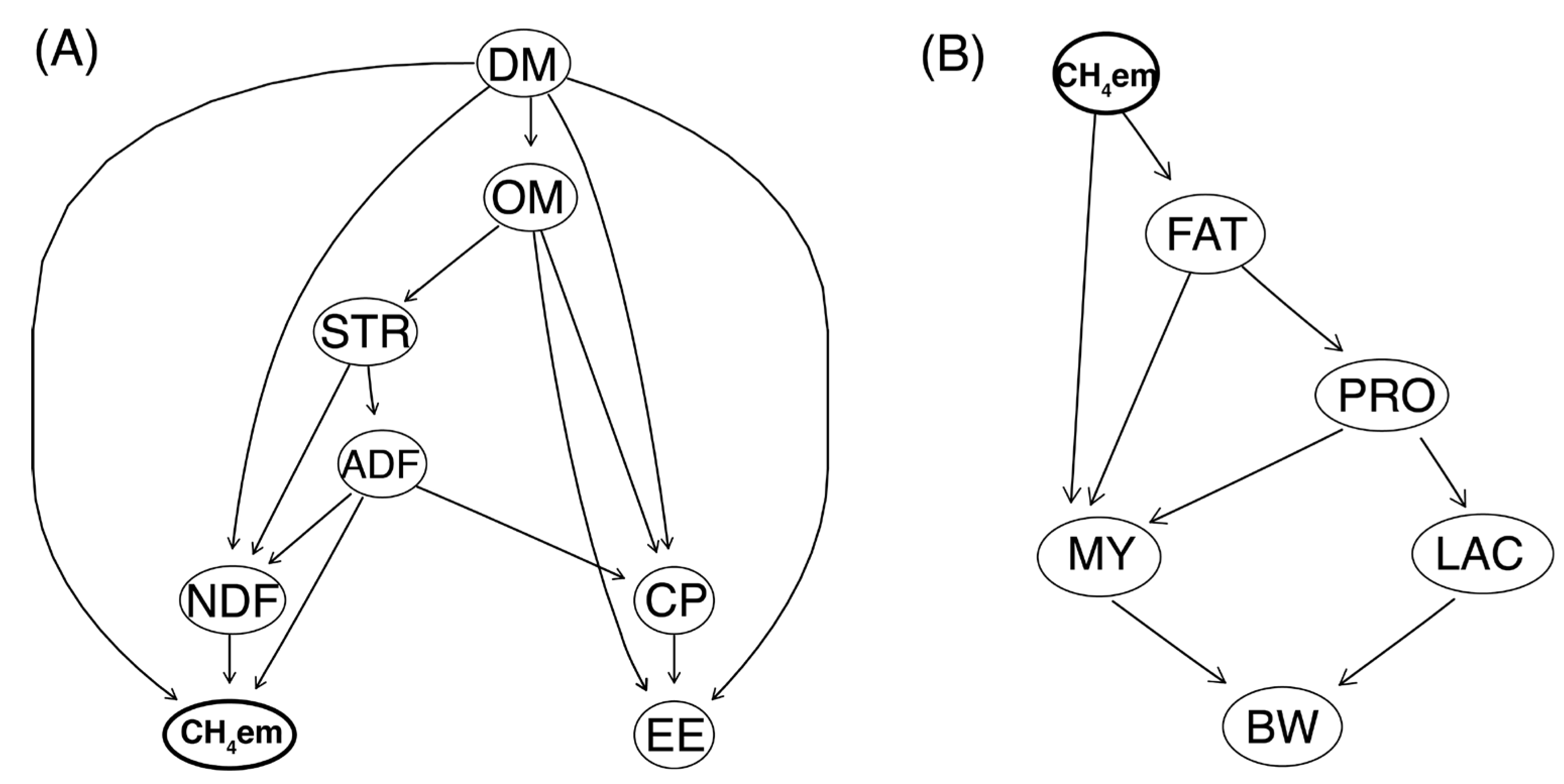Exploring Methane Emission Dynamics Using Bayesian Networks and Machine Learning Analysis of Nutritional and Production Traits in Dairy Cattle
Abstract
1. Introduction
2. Results
2.1. Correlations Among Diet Ingredients and Traits
2.2. ME Based on the Body Weight and Milk Yield Scales
2.3. Bayesian Network Structure Learning for the Diet Chemical Components and Production Traits
2.4. Quantifying the Influence of Key Factors on CH4-em
2.5. CH4-em Prediction Using Machine Learning Models (ML)
3. Discussion
3.1. Correlations Among Diet Ingredients and Traits
3.2. ME Based on the Body Weight and Milk Yield Scales
3.3. Bayesian Network Structure Learning for the Diet Chemical Components and Production Traits
3.4. Quantifying the Influence of Key Factors on CH4-em
3.5. CH4-em Prediction Using Machine Learning (ML) Models
3.6. Study Limitations and Generalizability
4. Materials and Methods
4.1. Meta Data
4.2. Variable Importance Quantification
4.3. Learning Interrelationship Structures Among Variables Using Bayesian Network
4.4. Machine Learning Predictive Models
5. Conclusions
Author Contributions
Funding
Data Availability Statement
Conflicts of Interest
References
- Maasakkers, J.D.; McDuffie, E.E.; Sulprizio, M.P.; Chen, C.; Schultz, M.; Brunelle, L.; Thrush, R.; Steller, J.; Sherry, C.; Jacob, D.J.; et al. A Gridded Inventory of Annual 2012–2018 U.S. Anthropogenic Methane Emissions. Environ. Sci. Technol. 2023, 57, 16276–16288. [Google Scholar] [CrossRef]
- Minx, J.C.; Lamb, W.F.; Andrew, R.M.; Canadell, J.G.; Crippa, M.; Döbbeling, N.; Forster, P.M.; Guizzardi, D.; Olivier, J.; Peters, G.P.; et al. A Comprehensive and Synthetic Dataset for Global, Regional, and National Greenhouse Gas Emissions by Sector 1970–2018 with an Extension to 2019. Earth Syst. Sci. Data 2021, 13, 5213–5252. [Google Scholar] [CrossRef]
- Liu, Z. How Much Gas Do Beef or Dairy Cattle Produce? Kansas State University Agricultural Experiment Station and Cooperative Extension Service: Manhattan, KS, USA, 2015. [Google Scholar]
- Honan, M.; Feng, X.; Tricarico, J.M.; Kebreab, E. Feed Additives as a Strategic Approach to Reduce Enteric Methane Production in Cattle: Modes of Action, Effectiveness and Safety. Anim. Prod. Sci. 2021, 62, 1303–1317. [Google Scholar] [CrossRef]
- Velarde-Guillén, J.; Pellerin, D.; Benchaar, C.; Wattiaux, M.A.; Charbonneau, É. Development of an Equation to Estimate the Enteric Methane Emissions from Holstein Dairy Cows in Canada. Can. J. Anim. Sci. 2019, 99, 792–803. [Google Scholar] [CrossRef]
- Beauchemin, K.A.; McAllister, T.A.; McGinn, S.M. Dietary Mitigation of Enteric Methane from Cattle. CABI Rev. 2009, 4, 1–18. [Google Scholar] [CrossRef]
- Hammond, K.J.; Humphries, D.J.; Westbury, D.B.; Thompson, A.; Crompton, L.A.; Kirton, P.; Green, C.; Reynolds, C.K. The Inclusion of Forage Mixtures in the Diet of Growing Dairy Heifers: Impacts on Digestion, Energy Utilisation, and Methane Emissions. Agric. Ecosyst. Environ. 2014, 197, 88–95. [Google Scholar] [CrossRef]
- Danielsson, R.; Dicksved, J.; Sun, L.; Gonda, H.; Müller, B.; Schnürer, A.; Bertilsson, J. Methane Production in Dairy Cows Correlates with Rumen Methanogenic and Bacterial Community Structure. Front. Microbiol. 2017, 8, 226. [Google Scholar] [CrossRef]
- Donadia, A.B.; Oliveira, A.S. Complete Dataset of the Methane Submodel, The Nutrition System for Dairy Cows (NS Dairy Cattle); Dairy Cattle Research Lab, Universidade Federal de Mato Grosso, Campus Sinop: Mato Grosso, Brazil, 2023; Mendeley Data. Mendeley Data 1. Available online: https://data.mendeley.com/datasets/gbrjnh89zj/1 (accessed on 15 September 2025).
- Donadia, A.B.; Torres, R.N.S.; Silva, H.M.d.; Soares, S.R.; Hoshide, A.K.; Oliveira, A.S.d. Factors Affecting Enteric Emission Methane and Predictive Models for Dairy Cows. Animals 2023, 13, 1857. [Google Scholar] [CrossRef]
- Knapp, J.R.; Laur, G.L.; Vadas, P.A.; Weiss, W.P.; Tricarico, J.M. Invited Review: Enteric Methane in Dairy Cattle Production: Quantifying the Opportunities and Impact of Reducing Emissions. J. Dairy Sci. 2014, 97, 3231–3261. [Google Scholar] [CrossRef]
- Gerber, P.J.; Henderson, B.; Makkar, H.P.S. Mitigation of Greenhouse Gas Emissions in Livestock Production: A Review of Technical Options for Non-CO2 Emissions; Food and Agriculture Organization of the United Nations: Roma, Italy, 2013; ISBN 9789251076583. [Google Scholar]
- Hristov, A.N.; Oh, J.; Firkins, J.L.; Dijkstra, J.; Kebreab, E.; Waghorn, G.; Makkar, H.P.S.; Adesogan, A.T.; Yang, W.; Lee, C.; et al. SPECIAL TOPICS—Mitigation of Methane and Nitrous Oxide Emissions from Animal Operations: I. A Review of Enteric Methane Mitigation Options1. J. Anim. Sci. 2013, 91, 5045–5069. [Google Scholar] [CrossRef]
- Patra, A.K. Recent Advances in Measurement and Dietary Mitigation of Enteric Methane Emissions in Ruminants. Front Vet. Sci. 2016, 3, 39. [Google Scholar] [CrossRef]
- Rymer, C.; Huntington, J.A.; Williams, B.A.; Givens, D.I. In Vitro Cumulative Gas Production Techniques: History, Methodological Considerations and Challenges. Anim. Feed Sci. Technol. 2005, 123–124, 9–30. [Google Scholar] [CrossRef]
- Scoones, I. Livestock, Methane, and Climate Change: The Politics of Global Assessments. Wiley Interdiscip Rev. Clim. Change 2023, 14, e790. [Google Scholar] [CrossRef] [PubMed]
- Huhtanen, P.; Krizsan, S.J.; Ramin, M. A Meta-Analysis of Faecal Output and Nutrient Composition, and Potential Methane Emission from Manure of Dairy Cows. Anim. Feed Sci. Technol. 2021, 282, 115120. [Google Scholar] [CrossRef]
- Gislon, G.; Colombini, S.; Borreani, G.; Crovetto, G.M.; Sandrucci, A.; Galassi, G.; Tabacco, E.; Rapetti, L. Milk Production, Methane Emissions, Nitrogen, and Energy Balance of Cows Fed Diets Based on Different Forage Systems. J. Dairy Sci. 2020, 103, 8048–8061. [Google Scholar] [CrossRef] [PubMed]
- Fresco, S.; Boichard, D.; Fritz, S.; Lefebvre, R.; Barbey, S.; Gaborit, M.; Martin, P. Comparison of Methane Production, Intensity, and Yield throughout Lactation in Holstein Cows. J. Dairy Sci. 2023, 106, 4147–4157. [Google Scholar] [CrossRef]
- Janssen, P.H.; Kirs, M. Structure of the Archaeal Community of the Rumen. Appl. Environ. Microbiol. 2008, 74, 3619–3625. [Google Scholar] [CrossRef]
- Pszczola, M.; Calus, M.P.L.; Strabel, T. Genetic Correlations between Methane and Milk Production, Conformation, and Functional Traits. J. Dairy Sci. 2019, 102, 5342–5346. [Google Scholar] [CrossRef]
- Dong, L.-F.; Jia, P.; Li, B.-C.; Wang, B.; Yang, C.-L.; Liu, Z.-H.; Diao, Q.-Y. Quantification and Prediction of Enteric Methane Emissions from Chinese Lactating Holstein Dairy Cows Fed Diets with Different Dietary Neutral Detergent Fiber/Non-Fibrous Carbohydrate (NDF/NFC) Ratios. J. Integr. Agric. 2022, 21, 797–811. [Google Scholar] [CrossRef]
- Ellis, J.L.; Dijkstra, J.; Kebreab, E.; Bannink, A.; Odongo, N.E.; McBRIDE, B.W.; France, J. Aspects of Rumen Microbiology Central to Mechanistic Modelling of Methane Production in Cattle. J. Agric. Sci. 2008, 146, 213–233. [Google Scholar] [CrossRef]
- Janssen, P.H. Influence of Hydrogen on Rumen Methane Formation and Fermentation Balances through Microbial Growth Kinetics and Fermentation Thermodynamics. Anim. Feed Sci. Technol. 2010, 160, 1–22. [Google Scholar] [CrossRef]
- Berger, R.L. Likelihood Ratio Tests and Intersection-Union Tests. In Advances in Statistical Decision Theory and Applications; Birkhäuser Boston: Boston, MA, USA, 1997; pp. 225–237. [Google Scholar]
- Heckerman, D. A Tutorial on Learning with Bayesian Networks. In Innovations in Bayesian Networks: Theory and Applications; Springer: Berlin/Heidelberg, Germany, 2008; pp. 33–82. [Google Scholar]
- Scutari, M. Learning Bayesian Networks with the Bnlearn R Package. arXiv 2009, arXiv:0908.3817. [Google Scholar]
- Scutari, M.; Denis, J.-B. Bayesian Networks: With Examples in R; CRC Press: Boca Raton, FL, USA, 2021; ISBN 1000410382. [Google Scholar]
- Hastie, T.; Tibshirani, R.; Friedman, J. The Elements of Statistical Learning: Data Mining, Inference, and Prediction, 2nd ed.; Springer: New York, NY, USA, 2009. [Google Scholar] [CrossRef]
- Tibshirani, R. Regression Shrinkage and Selection via the Lasso. J. R. Stat. Soc. Ser. B 1996, 58, 267–288. [Google Scholar] [CrossRef]
- Rasmussen, C.E.; Williams, C.K.I. Gaussian Processes for Machine Learning; MIT Press: Cambridge, MA, USA, 2006. [Google Scholar] [CrossRef]



| Group | From 1 | To | BIC | Strength 2 | Direction 3 |
|---|---|---|---|---|---|
| Nutritional factors | DM | ME | −8.186 | 0.980 | 0.700 |
| DM | EE | −0.417 | 0.570 | 0.770 | |
| DM | NDF | −5.355 | 1.000 | 0.820 | |
| OM | CP | −10.342 | 1.000 | 0.840 | |
| OM | EE | −1.065 | 0.740 | 0.910 | |
| OM | STR | 0.130 | 0.880 | 0.580 | |
| CP | EE | 0.033 | 0.890 | 0.650 | |
| NDF | ME | −7.400 | 0.940 | 0.650 | |
| ADF | ME | 0.903 | 0.850 | 0.570 | |
| ADF | CP | −4.284 | 0.800 | 0.880 | |
| ADF | NDF | −3.637 | 0.750 | 0.970 | |
| STR | NDF | 0.744 | 0.950 | 0.620 | |
| Production traits | ME | MY | −14.879 | 0.815 | 0.662 |
| ME | FAT | 0.935 | 0.321 | 0.634 | |
| MY | BW | −32.287 | 1.000 | 0.610 | |
| FAT | MY | −10.376 | 0.937 | 0.597 | |
| FAT | PRO | −36.418 | 1.000 | 0.583 | |
| PRO | MY | −6.289 | 0.966 | 0.502 | |
| PRO | LAC | 1.164 | 0.163 | 0.654 | |
| PRO | BW | −4.787 | 0.728 | 0.636 |
| Group | Variable 1 | (SE) | Chisq. () | LRT Pr (>Chisq) |
|---|---|---|---|---|
| Nutritional factors | DM | 0.216 (0.115) | 1.025 | 0.598 |
| OM | 2.101 (1.55) | 1.249 | 0.535 | |
| CP | −1.69 (0.968) | 0.701 | 0.704 | |
| EE | 0.021 (2.69) | 0.72 | 0.868 | |
| NDF | 0.827 (0.289) | 12.166 | 0.002281 ** | |
| ADF | 1.80 (0.648) | 2.437 | 0.295 | |
| STR | −0.612 (0.265) | 0.697 | 0.705 | |
| Production traits | BW | 2.106 (0.84) | 0.0372 | 0.847 |
| MY | 3.892 (0.95) | 25.187 | 5.20 × 10−7 *** | |
| FAT | 2.572 (1.41) | 14.954 | 1.10 × 10−4 *** | |
| PRO | 0.862 (2.92) | 0.7612 | 0.383 | |
| LAC | 0.301 (3.49) | 0.0262 | 0.8715 |
| Model 1 | Diet Variables | Production Variables | |||
|---|---|---|---|---|---|
| MSE | MSE | ||||
| Linear | OLS | 2826.551 | 0.682 | 7104.972 | 0.196 |
| LASSO | 2826.907 | 0.682 | 7105.047 | 0.196 | |
| RR | 3000.052 | 0.666 | 7110.495 | 0.196 | |
| EN | 2826.85 | 0.682 | 7105.053 | 0.196 | |
| Non-linear | PLSR | 2826.963 | 0.682 | 7104.972 | 0.196 |
| SPL | 1494.579 | 0.832 | 5764.416 | 0.348 | |
| SVM | 3011.716 | 0.731 | 3652.175 | 0.595 | |
| GP | 2242.79 | 0.844 | 1969.975 | 0.861 | |
Disclaimer/Publisher’s Note: The statements, opinions and data contained in all publications are solely those of the individual author(s) and contributor(s) and not of MDPI and/or the editor(s). MDPI and/or the editor(s) disclaim responsibility for any injury to people or property resulting from any ideas, methods, instructions or products referred to in the content. |
© 2025 by the authors. Licensee MDPI, Basel, Switzerland. This article is an open access article distributed under the terms and conditions of the Creative Commons Attribution (CC BY) license (https://creativecommons.org/licenses/by/4.0/).
Share and Cite
Mohammadabadi, M.; Roudbar, M.A.; Momen, M.; Mousavi, S.F.; Momen, M. Exploring Methane Emission Dynamics Using Bayesian Networks and Machine Learning Analysis of Nutritional and Production Traits in Dairy Cattle. Methane 2025, 4, 21. https://doi.org/10.3390/methane4030021
Mohammadabadi M, Roudbar MA, Momen M, Mousavi SF, Momen M. Exploring Methane Emission Dynamics Using Bayesian Networks and Machine Learning Analysis of Nutritional and Production Traits in Dairy Cattle. Methane. 2025; 4(3):21. https://doi.org/10.3390/methane4030021
Chicago/Turabian StyleMohammadabadi, Mohammadreza, Mahmoud Amiri Roudbar, Moslem Momen, Seyedeh Fatemeh Mousavi, and Mehdi Momen. 2025. "Exploring Methane Emission Dynamics Using Bayesian Networks and Machine Learning Analysis of Nutritional and Production Traits in Dairy Cattle" Methane 4, no. 3: 21. https://doi.org/10.3390/methane4030021
APA StyleMohammadabadi, M., Roudbar, M. A., Momen, M., Mousavi, S. F., & Momen, M. (2025). Exploring Methane Emission Dynamics Using Bayesian Networks and Machine Learning Analysis of Nutritional and Production Traits in Dairy Cattle. Methane, 4(3), 21. https://doi.org/10.3390/methane4030021







